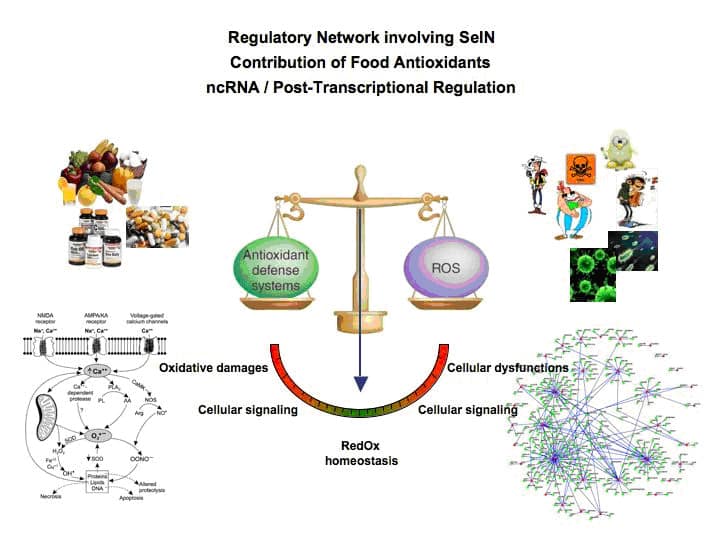We are interested to understand the impact of nutrition on oxidative homeostasis and control. Our goal is to develop an integrative model – from the molecule to the whole organism – to study the physiological response and the mechanisms of regulation related to oxidative stress response.
The maintenance of a reductive-oxidative (redox) equilibrium status within the cell involves multiple pro- and antioxidative factors: the first are constituted by a large diversity of stress-inducing factors (xenobiotic, radiation, environmental changes…); the second involve intracellular defense systems, mostly enzymes (catalase, superoxide dismutase…). Nutrients such as vitamins and trace elements directly participate to the control of redox equilibrium. Inadequate intake results in various diseases always related to an elevated oxidative status. Selenium, one of the trace elements involved in oxidative stress defense, is the subject of our investigations. Specifically incorporated into a family of proteins as a selenocysteine residue, it confers increased nucleophilic and reductive reactivities. Nevertheless the knowledge concerning the function of these seleno-enzymes and their contribution to the global redox homeostasis remain still partial.
For a decade our lab is involved in the discovery and characterization of selenium containing proteins. Undertaken searches focus more particularly on the Selenoprotein N (SelenoN), previously identified in the unit. SelenoN was the first selenium containing protein shown to be directly involved in human inherited diseases. Mutations in SELENON human gene cause a group of rare muscular disorders characterized by predominant affection of axial muscles.
We have developed a transgenic mouse (Selenon-/-), knockout for the Selenon gene coding for SelenoN. This mutated mouse constitutes an interesting animal model for the muscular disease. Moreover, the Selenon-/- mouse presents an increased susceptibility to oxidative stress, and will be used as a model to study the impact of selenium and vitamine E to the complex mechanisms of oxidative-reduction control.
Our works aim to characterize the physiologic dysfunction participating to the muscular disorder and to understand the molecular and cellular roles of SelenoN, towards therapeutical applications. Moreover, we are interested in understanding the contribution of SelenoN to the redox control network within the cell.
To tackle these fundamental and medical tasks, we have developed an integrative approach based on biochemical, genetics, molecular and cellular, as well as structural studies.
With the opening in 2015 of the « Laboratoire Commun » DiagnOxi within the framework of a public/private partnership, our objectives also intend to develop exploratory researches in fundamental science to initiate innovative strategies and to meet the needs for future animal nutrition and health.

Our goals are:
- to identify the role of selenium in muscle function
- to characterize the regulatory network involving SelN
- to understand the contribution of food antioxidants to redox control
- to identify non-coding RNAs contributing to post-transcriptional regulation related oxidative stress defense and adaptation.
Our works are supported by



 Intranet
Intranet Access
Access Contact
Contact
